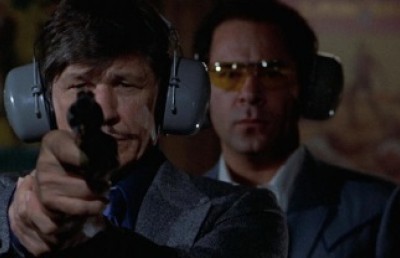Sweet Sweetback’s Baadasssss Song (Melvin van Peebles, 1971)
Vinegar Syndrome
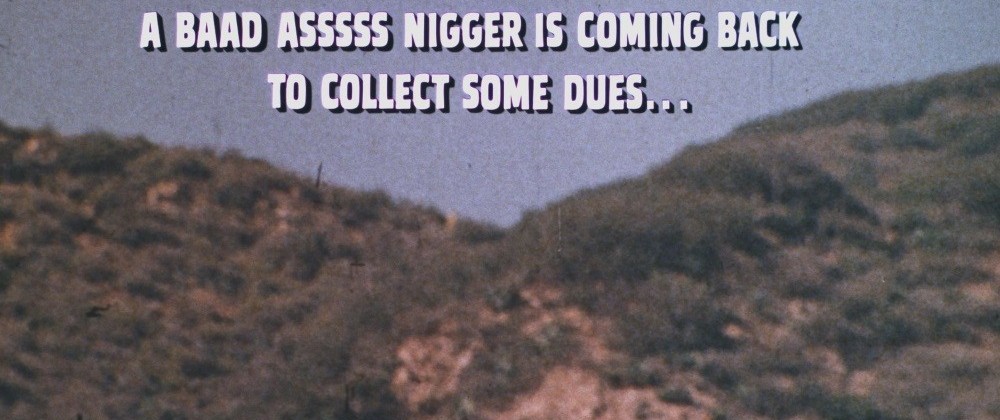
For many years now the video label Vinegar Syndrome (which is partnered with an in-house lab, OCN Digital Labs) has been at the top of the heap when it comes to preserving and promoting cult cinema. Their dedication to salvaging certain films from complete deterioration and certain destruction and providing the best transfers and in-depth special features for forgotten, orphaned and DIY/independent films has endeared them to cult cinema fans everywhere. Vinegar Syndrome specializes in films from the 1960s to 1980s, horror, science-fiction, exploitation, sexploitation, etc., and has a catalogue of feature films in the hundreds. Every now and then they release a film which has greater historical relevance than their usual titles, which is the case with their 2018 BD/DVD combo release of Melvin Van Peeble’s raunchy crime/chase drama that can rightly be called one of the most revolutionary American films ever made, Sweet Sweetback’s Baadasssss Song. In terms of radicalism, the closest an American film has gotten to a Jean-Luc Godard film of the late 1960s, early 1970s (though it is a lot more fun than those films!).
After a having made a trio short films in France based on his own short stories, using the experience to self-teach himself filmmaking, writer-musician-filmmaker Melvin Van Peebles made a racial parable comedy for Columbia Studios, Watermelon Man (1970), in which a white man (Godfrey Cambridge in not very convincing white face), wakes up to find himself black and learns first hand what it is like being black in America. No doubt influenced by the 1961 book by Texan John Howard Griffin and same titled 1964 film Black Like Me, in which a white reporter assumes a black identity and travels the South to record his experiences, Watermelon Man turned out to be a moderate success for Columbia Studios and who were sufficiently pleased to offer Van Peebles a three picture deal. But Van Peebles experienced enough creative interference while working on the film to realize that he could never make the kind of revolutionary film he had in mind under a studio, hence he set off to make a film on his own terms. Which is why the production history of the film, duly noted in several articles and covered in the wealth of special features on the BD/DVD, makes for some fascinating stories. Like the way he decided to use a crew made up of non-professionals and porn film technicians to circumvent union rules against the use of non-professional crew members (many of whom were black). ). And then to keep the union off his back, Van Peebles feigned that he was making a porn film.
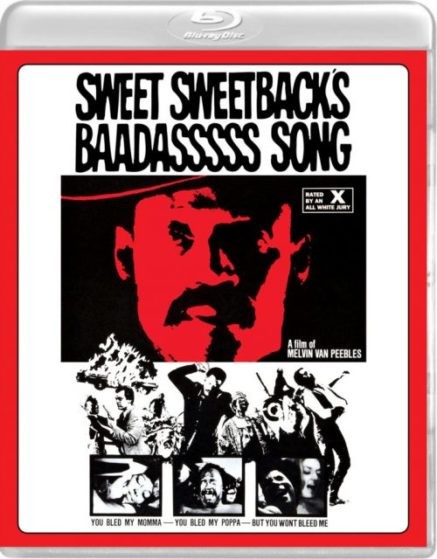
In the film Melvin Van Peebles plays a black gigolo nicknamed Sweetback for his sexual prowess –and legend has it that some of the scenes featured non-simulated sex (maybe those scenes where there was a union visit?). The most controversial scene is the early flashback scene where a young Van Peebles (played by his own 13-yeard old son, Mario Van Peebles) is coerced into sex by a prostitute. To finish the post production of the film Van Peebles had to borrow $50,000 from Bill Cosby. In the end, Sweet Sweetback’s Baadasssss Song was made wholly independently for $500,000, $100,00 of his own, the rest deferred, borrowed from friends, and gained through promotional stunts. The production history is so colorful that it was the inspiration for a fascinating part-documentary, part-dramatized ‘making of’ by his son Mario Van Peebles, Baadasssss! (2003), in which Mario plays his father.
Sweet Sweetback’s Baadasssss Song is political in many ways, most notably in its formal experimentation and its main through line of a black man killing two white LA police officers and then forced into a hunter-chased plot. Sweetback’s beating of the two cops is not a planned attack or a retaliation, but an act to defend the young black man in police custody who is being beaten for no reason. This sets up the slim plot of the film, singular in its action, of Sweetback running (and there is lots of running in the film) and hiding to avoid the police who have been mobilized to track down this “cop killer”. The police in the film are corrupt, brutal and above the law, torturing a pimp by setting off a gun next to his ear (causing him to go permanently deaf). In another scene they break into a bedroom where a black man they think is Sweetback is in the throes of sex with a white woman. They grab and beat him violently, then, holding his bloodied face up to the camera, an off screen voice says, “It’s not him”, to which another voice nonchalantly responds, “So what”. If you are a police officer, shoot first then ask questions is the motto. In this regard, Melvin Van Peebles’ film makes an interesting comparison with Spike Lee’s BlacKkKlansman, where a police officer is the hero.
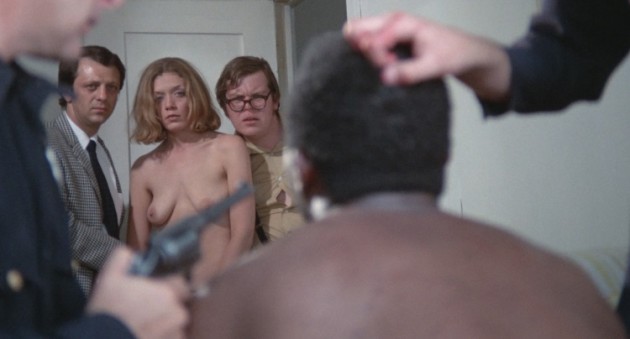
It’s not him. So what?
To understand the full political power of Sweet Sweetback’s Baadasssss Song you have to keep in mind that, as Travis Crawford notes in the liner notes, in 1970 there were only two black filmmakers working in the Hollywood studio system: Gordon Parks Sr., who directed The Learning Tree in 1969 and Shaft in 1971, which should be acknowledged as the first true Blaxploitation film, and Ossie Davis, whose Cotton Comes to Harlem (1970) was released the same week as Sweet Sweetback’s Baadasssss Song. Images of empowered black men were rare in Hollywood up to 1970 (not discounting of course the hundreds of Negro Films made from the 1910s to the 1930s from such studios as Foster Photoplay Company, The Ebony Film Co., The George P and Noble Johnson’s Lincoln Motion Picture Company, Oscar Micheaux Pictures, Spencer Williams’ Amegro Film, and the white run The Colored Players Film Association). Things would change seemingly abruptly with the cycle of blaxploitation films that would run from 1971 to 1980. Although Sweet Sweetback’s Baadasssss Song is seen as a major influence on the blaxploitation movement, with the black power ethos, the super charged black hero, the revenge theme, and other elements, it is not properly speaking a blaxploitation film, since the cycle or genre had not yet started. The MGM produced Shaft was the one that signalled the black film as a commercially viable sub-genre of the crime film. But clearly, in hindsight, which is an acceptable position to hold when it comes to genre theory, where industry and critical conceptions of genre differ, Sweet Sweetback’s Baadasssss Song is the grandfather of blaxploitation. Even though it is different in one important manner, which I will return to later, there is some context that is necessary to understanding the blaxploitation cinema.

Experimentalism
In the chapter “Black is Box-Office” from his book From Sambo to Superspade Daniel J. Leab lays out the industry context that set the path for the Blaxploitation movement of the 1970s, of which Sweet Sweetback’s Baadasssss Song is a torchlight (in the sense of influencing later blaxploitation). Leab notes that in 1963 NAACP threatened legal and economic action if the film industry did not start hiring black actors, and as a result the appearance of blacks in films increased substantially from the early 1960s to the late 1970s (spurned by the box-office success of many of these films). This culminated in the “superspade” of the blaxploitation film, which may not have been what the NAACP had in mind, but it helped the industry to realize the potential of black cinema and was a whole lot more appealing for black audiences than Sambo stereotypes of the earlier period (which explains the anecdotal evidence of black audiences cheering and clapping during scenes of black characters beating on white characters). In 1967 a study revealed that in major cities blacks made up 30% of box-office take, while being only 15% of the population. So studios caught on, and black actors began to appear in films more frequently, and many white directors were at the helm of black-cast led blaxploitation films (though quite a few blaxploitation films were directed by black directors, such as Melvin Van Peebles, Sidney Poiter, Bill Gunn, and Jamaa Fanaka. The first black super star was football player Jim Brown, establishing the trend of black athletes as actor stars that would continue for decades, right up to BlacKkkKansman, as John David Washington was a college football player, like Shaft star Richard Roundtree before him. Other black male athlete turned action stars continued, with Fred Williamson, Jim Kelly, and O.J. Simpson. Leab outlines the importance of Jim Brown, who appeared in Rio Conchos (1964), The Dirty Dozen (1967) and The Dark of the Sun (1968). Then in the 1970 The Grasshopper Jim Brown plays a character who savagely beats a white man who killed his wife. And to set the template of the super sexy, super virile black hero, which includes Sweetback, Shaft and Superfly, Jim Brown played sex scenes opposite white actresses (often playing mixed race, like Rachel Welch in 100 Rifles). Ossie Davis played opposite Burt Lancaster in the Scalphunters (1968) and gets in a fist fight with the Lancaster character, Leab speculates this as a case of the first time in a film a white man does NOT win in a fight with a black man. (As an aside, I am reminded of the brutal beating of a black undercover detective by the Nicolas Cage character in the opening scene of Wild at Heart, and the death of Ned (Morgan Freeman) by the abusive, sadistic sheriff Little Bill Daggett (Gene Hackman) ). Leab highlights a forgotten black American actor who was a big star during the 1970s, Raymond St. Jacques. St. Jacques starred in Change of Mind (1969, Robert Stevens), which recounts a story where the brain of a liberal white southern man dying of cancer is put into the body of a black man, foreshadowing Get Out which featured the same body-brain switching idea. Cotton Comes to Harlem (1970), directed by actor Ossie Davis, starred Godfrey Cambridge and St. Jacques as detective partners. 1971 was a watershed year with the release of Sweet Sweetback’s Baadasssss Song and Shaft. Peebles was the first American black man to direct a movie —though it was French— to be commercially released in the US: The Story of a Three-day Pass (1968), the success of which made Columbia studios seek out Van Peebles and eventually make The Watermelon Man.
Within this context, we can understand the economic backdrop to the blaxploitation cycle of films, which may be the only time in American film history where the forces of the capitalist marketplace and potential ideological forces (black power, anarchism, anti-authority sensibility) against it formed a happy if uneasy marriage. Within this context, the extent of the black power dynamic in Sweet Sweetback’s Baadasssss Song was a cinematic Molotov cocktail. The primal nature of the scene where Sweetback beats up the two officers is brutal, as he bludgeons them, out of frame, with police handcuffs, thick blood visible on the cuffs and his hands. The scene is shot at night, in disorienting close-ups with the undulating off-screen sound of nearby oil derricks adding an oddly metaphoric machinic element. At every turn Sweetback outsmarts, outruns, outsexes and outfoxes “the Man” (or “the White Woman” in the case of the funny but unnerving ‘sex battle’ scene with a biker girl under a bridge overpass). The final scene is politicized by having it staged like a freed slave running for his freedom, with the train ride, the desolate desert setting, and the tribal and slave music (“They bled your Momma. They bled your Poppa. But you won’t bleed me”) . Sweetback eludes a red neck posse by killing the police dogs with his bare hands and running to safety across the Mexican border, with the title card warning, “Watch Out….A Baad Asssss Nigger is Coming Back to Collect Some Dues…..”
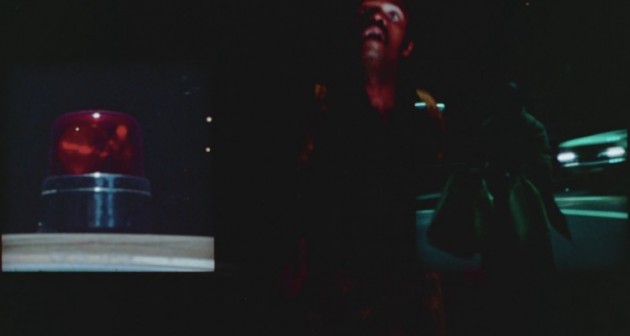
Experimentalism
As I stated above, although Sweet Sweetback’s Baadasssss Song is seen as a major influence on the blaxploitation movement, it is unlike any other blaxploitation film in one important manner: its cinematic radicalism. No other blaxploitation film is as experimental as Sweet Sweetback’s Baadasssss Song. The narrative structure is chaotic to the point of being confusing. The camera is relentless in its restlessness, full of whip pans, zooms, and abrupt hand-held movements. The cutting is aligned beautifully with its rhythmically enticing soundtrack, with the Earth, Wind and Fire music treated like an aural motif of repetitive passages with syncopated stops, starts and bursts. The frame is never settled for very long, with camera flare outs, abstract solarisations, split screens, zoom in/outs and out of focus shots unsettling the viewer. Several dialogue scenes between Sweetback and other characters are played as direct camera addresses, starting from a great scene (25 minutes in) where a pimp preaches to Sweetback while stepping out of a shower and –probably another cinema– sits on the toilet, has a bowel movement, and cleans his ass on camera. And a black preacher who stares into the camera and tells the off-screen Sweetback “I’ll say a black Ava Maria for you”.
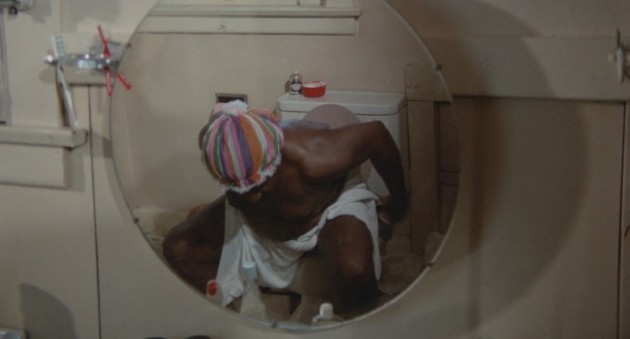
A cinema first?
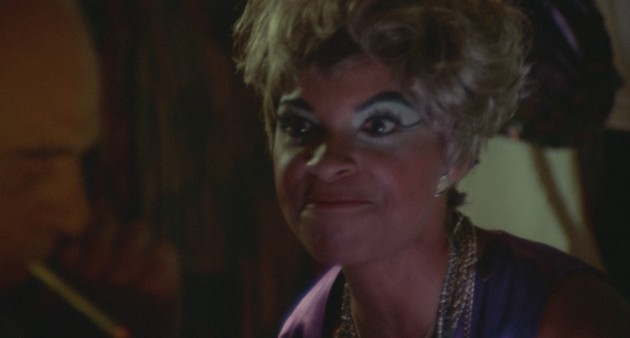
Female anger
The sense of experimentalism unchained is reflected in one of the greatest scenes in the film, the one where an angry black prostitute being ‘leaned on’ by a white parole officer in a hallway of flickering lights and ominous shadows, goes into a self-defined “nigger fit”, where she yells and screams at his face and directly into the camera, “Leeeeeeeave motherfucker”, with such unbridled energy that it feels like street art. When the man meekly leaves, she takes off her blond wig and begins to laugh hysterically. This ‘performance’ then cuts away to the same woman on a stage singing and gyrating her body, with her voice replaced by blaring music. It’s an exhilarating cinematic moment which advances the narrative no where and exists simply to give Van Peebles a chance to vent some female frustration at “the Man.”
What makes the film’s formal experimentalism clever is how it falls away during the scenes with the police commissioner and his lackeys. These “white” scenes are filmed in a flat and dull manner, with restricted camera movements, high key lighting, ‘empty’ sound tone, and no music. It’s a subtle but potent political message: white folk are not cool, white folk are not hip. (In these scenes actor John Dullaghan is great as the angry, racist Police Commissioner.)
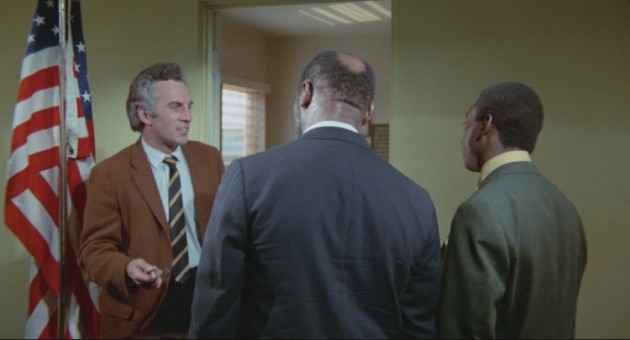
Dull ‘white scene’ #1
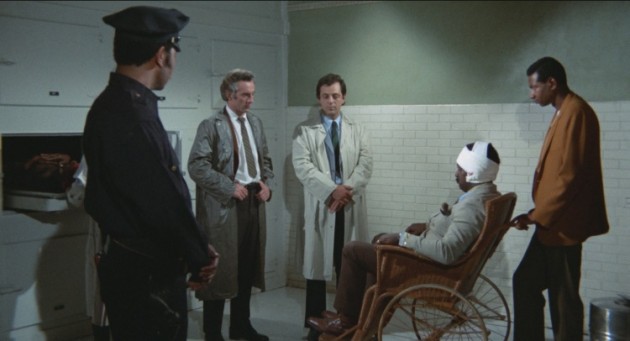
Dull ‘white scene’ #2
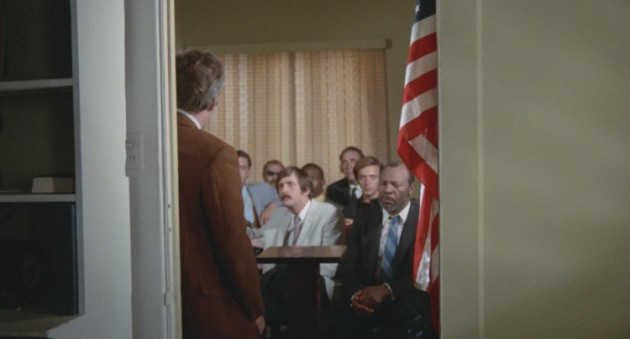
Dull ‘white scene’ #3
Sweet Sweetback’s Baadasssss Song became a surprise hit, and for a long time remained one of the most profitable independent films of all-time. Coming out during the peak of racial unrest and the Civil Rights movement and the rise of Black Power, the film would expectedly divide critics, black and white. But its potential revolutionary power was noted by the Black Panthers, who would devote an entire issue of The Black Panther to the film’s revolutionary implications (He Won’t Bleed Me: A Revolutionary Analysis of ‘Sweet Sweetback’s Baadasssss Song); but other black critics were less congratulatory. In a now famous review in a 1971 issue of the black magazine Ebony, titled “The Emancipation Orgasm: Sweetback In Wonderland”, critic Lerone Bennet’s uses the film as a counter-example to the kind of films black audiences need and deserve. Of course The Black Panthers and Ebony, which Ed Guerrero called the then “principal organ of the black bourgeoisie,” 1 , are two ideological extremes of black consciousness. But one thing is certain, the financial success of Sweet Sweetback’s Baadasssss Song, proved that an independently made film, even one as fiercely independent and politically dangerous as this one, can have a wider appeal than imagined. The success proved to Hollywood that black themed films could be profitable, which opened the door not only to the blaxploitation cycle, but for future black and independent filmmakers, from Julie Dash to Jamaa Fanaka to Charles Burnett to Spike Lee to Ava Duvernay to Barry Jenkins.
The Vinegar Syndrome DVD/BD of Sweet Sweetback’s Baadasssss Song is a revelation. Outside of a few minutes of slightly inferior image, explained in an opening title card, the transfer is excellent, with strong vibrant colors, genuine film grain and a thick, well balanced sound track. The extensive special features are educational and fun. An added audio is an informative feature-length commentary with film historian Sergio Mims, who contextualizes the film in relation to both the industry and broader cultural trends, while adding a personal touch, having interviewed Van Peebles on a few occasions. To his credit Mims does not gloss over the problematic aspects of the film, like the representation of the women and the sex scene with 13-year old Mario Van Peebles. There is a ‘Making of” from 2002 entitled “The Real Deal (What it Was…Is!)”, which sees Van Peebles walking the streets of Paris and in his apartment giving us his words of black wisdom and thoughts on the film (22 minutes); a straight forward talking head documentary of Van Peebles talking about his filmmaking career (23 min.). More interesting is a Q & A with Van Peebles from the 2013 Black Panther Film Festival at the Maysles Center in Harlem (36 minutes). And an interview with actress Niva Rochelle “One Baadasssss Woman!”, the woman from the “yelling” scene I described above (32 minutes). Rounding out the special features is a gallery of archival newspaper clippings, a trailer, and excellent liner notes by Travis Crawford.
When Sweet Sweetback’s Baadasssss Song was completed in a wholly independent spirit, there was a new rating system in place since 1968 called the MPAA, led by Jack Valenti. As Sergio Mims notes in his informative commentary track, the MPAA had a rule that any film not submitted to the MPAA for a rating would receive an X rating, which in those days did not have the stigma of pornography. It was simply meant to designate a film not suited to all audiences. Films such as Midnight Cowboy (1969) and A Clockwork Orange) (1971) were branded an X-Rating. Van Peebles did not submit his film to the MPAA, and used this as a promotional device by printing on the original poster marketing the film, “Rated X by an All-Whyte Jury”.
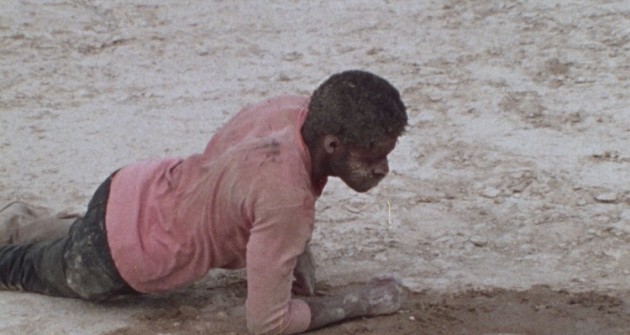
A ‘freed slave’
In writer Darius James’ 1995 critical/anecdotal book survey of blaxploitation film, the title of which owes much to Van Peebles, That’s Blaxploitation!: Roots of the Baadasssss ‘Tude (Rated X by an All-Whyte Jury), he gives Van Peebles his due by opening his book with an interview with Melvin Van Peebles, appropriately titled “Melvin Van Peebles: Original Guerilla”. The timely release of Vinegar Syndromes DVD/BD of Sweet Sweetback’s Baadasssss Song carries James’ mantle one step farther by giving us the definitive digital copy of this important, ground-breaking American film.
To order the film go to the Vinegar Syndrome website
BibliographyDaniel J. Leab. From Sambo to Superspade. Boston: Houghton Mifflin Company, 1975.
Darius James. That’s Blaxploitation!: Roots of the Baadasssss ‘Tude (Rated X by an All-Whyte Jury). New York: St. Martin’s Griffin, 1995.
Tambay A. Obenson. “Flashback To 1971 – Discord Over “Sweet Sweetback’s Baadasssss Song.” Indiewire, May 22, 2012.
Notes
- Indiewire, https://www.indiewire.com/2012/03/flashback-to-1971-discord-over-sweet-sweetbacks-baadasssss-song-147029/ ↩



-small_400_258_90_s_c1.jpg)
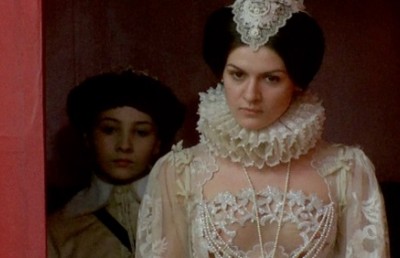
-small_400_258_90_s_c1.jpg)
